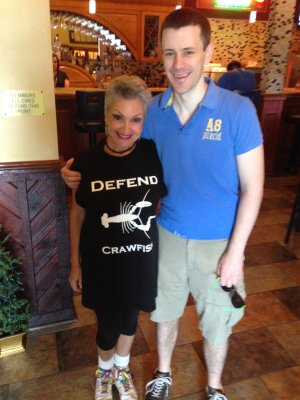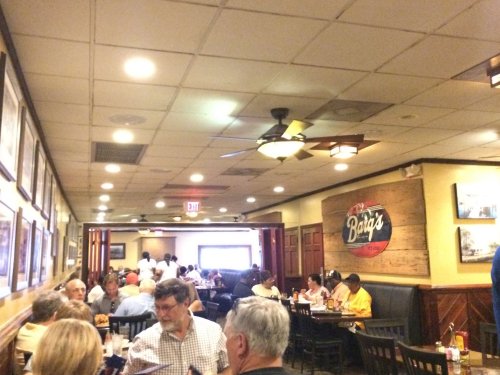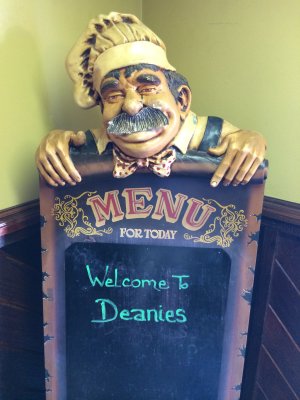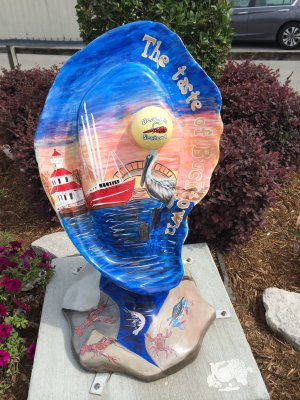METAIRIE, LOUISIANA
May 24, 2014
STRANGER: Mary Burns
LOCATION: Deanie’s Seafood, 1713 Lake Avenue, Metairie, Louisiana
THEME: An afternoon with a former teacher/zydeco dancer
“Anthony! How are ya, darlin’?!”
Mary Burns, a feisty 60-something with short hair, wide eyes and a permanent smile, reached out with both arms, hugged me tight and planted a kiss on both my cheeks. Then she stepped back and proudly showed off her “Defend Crawfish” sleeveless top.
I stood back and admired it, then noticed her earring design: alligators with gems for eyes, wearing the kind of washboards that feature prominently in Cajun music. Everything about her shouted the unique style that can only be described as New Orleans.

“You’re gonna have a real N’awlins day,” she said with a smile as she led me into Deanie’s Seafood, a local eatery in Bucktown, just outside New Orleans. Born in the city, Mary’s accent is thick Louisiana, twisting words into pronunciations I’d never heard before.
Her friendliness might be expected if we actually knew each other. But the last — and only time — I’d met Mary before lunch was in January. Three friends and I were in the Big Easy for a long weekend of good food, great cocktails and live music. At one point during daytime we wandered into the Maison club on Frenchmen Street. We were lured in by the upbeat, sometimes frantic zydeco music from the live band inside, enticed further by the patrons’ energetic dancing.
That’s when I saw Mary. Though diminutive in size, she was hard to miss as she raced around the dance floor, grabbing the hands of whoever didn’t have someone to shake it with. I’m not a dancer — check out my post-interview class with gypsy dancer Julia Kulakova for video proof. But there was something about Mary that made me want to join in. Bolstered by the 25-cent martinis my friends and I had at lunch, I walked up to her and I asked her if she wanted to dance.
I must have looked kind of nice, and so she took a chance. She twirled me around the dance floor, we shared some laughs, and afterward made vague promises to keep in touch.
And I followed through. She gave me a business card for a zydeco dance class she teaches, and on a return trip to New Orleans a few months later, I reached out to her.

That’s how Mary, my friend John (along for the trip) and I ended up back together for lunch in Bucktown, which used to be a fishing village before the U.S. Army Corp of Engineers built levees to prevent flooding in the area. “They have to ruin everything,” Mary sighed, rolling her eyes. “But I love this place,” she said of Deanie’s Seafood. “This is so Bucktown.”
What makes it Bucktown? I asked.
“It was named for a man called Buck,” deadpanned Mary, before breaking into a laugh — one of countless times throughout the afternoon that she threw out one-liners with perfect comic timing.
The upbeat, confident attitude is impressive given that she’s had several rough experiences: a terrifying time during Hurricane Katrina, her husband’s death, her daughter’s cancer. But one aside summed it up perfectly. “What are you gonna do?” she asked with a shrug.
Mary dances to keep her spirits up, and through her teaching gets to spread the fun of zydeco to others. But she hasn’t always been a dancing teacher. For three decades she was a schoolteacher, and throughout her life she’s lived in and around New Orleans.
Her house these days — which withstood Katrina’s battering – is just a few blocks from Deanie’s, one of her favorite places to eat. “I love my raw oysters” she said, pronouncing them “ersters,” and grinning when I told her to go ahead and order a full dozen. “They’re delish. I love them. I grew up on them. But you gotta get them where they haven’t sterilized them. Some places they’re washed, and you can tell. You want them salty.”
While our waiter took our orders for oysters and a few other dishes, Mary waved to another server she knew and they had a brief chat, catching up like old friends. “They all know me here as Miss Mary with the big mouth,” she said, laughing again.
Lunch at Deanie’s starts with a plate of boiled potatoes, instead of the typical bread most restaurants offer. It’s a welcome change. The boiled potatoes (“berled” potatoes in Mary speak) are seasoned so they’ve got a little spice if you eat them with the skin.

“These ain’t your ordinary potatoes,” Mary said. “And I know you’re British, but when I went to England and had your potatoes, I almost died. They were so boring!”
Mary visited England with her first husband, a marriage she says was done out of foolishness. Her second marriage was for love and continued until her spouse Jim’s death a few years ago. “My third marriage will be for money. Show me your wallet, baby!” she joked.
My head was still a little foggy a night enjoying the libations that New Orleans has to offer, but Mary’s energetic presence was enough to snap me right out of it. “Down here, if you aren’t hungover, you’re sick,” she said.
As Mary tells it, she’s always been the outgoing type.
She was born and raised in the city’s Ninth Ward. Not the Lower Ninth Ward that featured so prominently in headlines about the flooding during Katrina, but the other Ninth on the opposite side of the industrial canal that divides New Orleans from Metairie.
Educated at a Catholic school in this very religious city, Mary went to the University of New Orleans for a teaching degree. “I think I have a playful spirit. And I associated teaching with playing. The thought of being behind one desk all day — ugh,” she said, shaking her head.
After graduation, her entire teaching career was at the private Catholic school Saint Louise De Marillac (the patron saint of social services) in Arabi, Louisiana, which was a short distance from her house. By the time she started, she’d had a daughter, who attended the school. “I was insecure about being able to handle public school, so I went to where my daughter was.”

Mary had three different desks in her classroom, and would often switch up which one she’d sit at, partly to keep her students on their toes. “I had to compete with MTV. That’s the way I saw it. The kids had to want to watch me as much as they wanted to watch MTV.”
To keep their attention, she would sometimes show up to teach in character. And she’d break what she saw as uptight rules whenever she could. For example, one year when the school staff and pupils were having their yearbook photos taken, Mary let her class make all manner of wacky poses. That didn’t go down well with the dour principal who wanted straightforward profile pictures. The principal made Mary’s class retake the pictures — just one of many clashes she had with the higher-ups at her school. “I was always being called to the principal’s office,” she grinned.
Mary taught reading, spelling, religion and ran both the student government and drama clubs. She vividly remembers the hurdles with each of those subjects. “With reading, the kids always wanted to watch the video of the book. I told them no, they had to open the book, sound out the words.”
Religion wasn’t something she yearned to teach. The school was having problems finding a tutor, so its priest asked whether Mary would do it.
“I said let’s talk,” and then laughed as she rubbed her fingers together in the universal symbol for show-me-the-money. “That class incorporated sex education. Would you believe I had to get certified for sex education? Peg A goes in Slot B. That’s all! But anyway, I got my certification in that.”

Her humor teaching that class caused problems again. The name of the subject was Human Sexuality in the Catholic Church. “I said, ‘What the hell is this?’ There isn’t any in the church! You open the book: it says ‘Don’t!’. Okay, we’re finished. Take the test.”
The kids loved her — one student even asked to come into school when he had a fever, just so he wouldn’t miss the sex ed class – but not all the parents shared that sentiment. “My phone would ring off the hook with angry parents,” Mary said. Mimicking a sour-faced blowhard, she acted out a typical experience. “Miss Burns, you said something terrible in class. You said ‘penis’”
Shaking her head in fake shock, Mary said she’d reply, “I’m sorry, I meant to say ‘dick’.”
Some of the parents were “crazy,” according to Mary. “One time a parent complained about the pictures for sex ed. I told her, ‘Lady I didn’t design them. If I did I would have made them a lot prettier. You got a problem? Call God, call the pastor.’ Those parents were insane.”
Despite the hassle from parents and the run-ins with the principal, Mary loved teaching. But in the late 90s she started to get turned off by the creep of political correctness.
Before she could tell us about her glide-path out of teaching, our waiter brought over an appetizer of artichoke hearts for my vegetarian friend John.

They looked great, but Mary had already threatened me with having to try my first raw oyster, so I skipped on trying his starter. I figured it’d be best to steel my stomach with water and potatoes before trying an oyster.
While John ate, Mary told us about the last few years of her teaching life. She had an equitable approach to her students: “In my classroom you’re all equal. I don’t care how much money your mommy and daddy make, or where you’re from. I hate you all equally,” she said, chuckling.
But even with the joking, her motto for teaching was simple. And it was on a sign pinned to the bulletin board in her classroom: We Work Hard, We Play Hard, We Pray Hard.
“The students either loved me or hated me,” Mary said. But for those who did have a complaint against Miss Burns, she had a simple solution. She’d go through an elaborate process of having the disgruntled student take out a clean sheet of paper, double space and neatly write down their complaint, and make sure the spelling was correct. Then she’d ask the student to fold the paper over three times, and drop it in the nearest trash can. “I ain’t interested!” she said.

But increasing bureaucracy turned Mary off life as a teacher. School officials started to direct teachers on how to talk to pupils. If a student was caught cheating, they could no longer call it what it was. “We had to say that the kid inappropriately obtained material,” Mary said. “Bullshit! Call it cheating! I don’t care about hurting their feelings. I wasn’t gonna sit there and say all that scripted stuff.”
Federal intrusion into the school system was another factor that drove Mary to retire from teaching after three decades on the job. She’s got harsh words to say for Department of Education officials “who’ve never sat a day in their life in the classroom” and doesn’t think the department should even exist. “When I become president, that’s the first thing going! Louisiana should be saying what Louisiana students should be learning. It should be a local thing,” Mary said.
All those factors combined were enough to get her out of the school system. “I did 30 years. And I thought it was getting insane. So I got out,” she said.
Now she’s retired, she’s free of the stresses of the classroom.
Instead, she’s focused on her zydeco teaching and dancing, as well as a theater class she runs for senior citizens. Curious about what first got her interested in life on the dance floor, I asked her when she first learned how to zydeco. I wasn’t expecting a dramatic response.
That’s when she cleared her throat and stared into my eyes. For once her characteristic smile disappeared. She lowered her tone to almost a whisper.
“I’ll tell ya,” she said. “But it’s a brutal story.”
Click on this link to read part two of my interview with Mary.